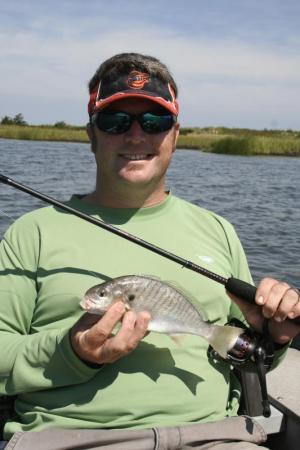Every spring I embarrass myself by predicting what fishing will be like in the coming year. Never one to be discouraged by constant failure, I will once again attempt to give my faithful readers my less-than-accurate opinion as to what they can expect to catch during the remainder of the year.
The one fish that has provided lots of action for me has been the hickory shad that invade Indian River Inlet each spring. You can catch them from boat or shore on shad darts or small silver spoons. I use a small Stingsilver-type metal lure for weight with a shad dart tied 6 to 8 inches behind while fishing from the sidewalk just west of the inlet bridge.
When fishing from a boat, I use the same rig, but being more mobile, I can chase the birds as the fish chase the bait around the inlet. Just cast to the bird action and you will be hit almost as soon as the rig hits the water.
Next up on the hit list will be summer flounder. While the scientists tell us the spawning success of the species is not what they would like to see, the stock is still high enough to maintain a status quo so far as regulations are concerned. That means Delaware will remain with a 16-inch size limit and a four-fish daily bag limit for 2023.
The Lewes-Rehoboth Canal and the Inland Bays will see the first flounder catches of the year. This is due to the shallow water that warms up before the deeper water in the ocean.
Plan your trips to coincide with the top of the flood tide and the beginning of the ebb. This allows the sun time to heat the water and get the flounder in a feeding mood. Work the shallow parts of the Indian River Bay being careful not to go blasting across the flats. Drift quietly across the shallow water, using your electric trolling motor. Then, use you outboard to run around the edge of the flat before beginning the drift again.
Fish the canal from Roosevelt Inlet either up the Broadkill River to Oyster Rocks or the down to the Freeman Bridge. Work the edge from shallow to deep and all dock pilings on the down current side.
Once the current begins to run out, pay particular attention to any ditch that enters the main body of water. Cast your bait up the ditch and allow the current to wash it back into the canal or bay.
Once the ocean water warms up, the flounder bite will improve offshore. Last year, four-fish bag limits were rare, and I don’t think we will see much improvement this year.
Then we have striped bass. I received my first report of a striped bass blitz from Shark River, N.J., March 28. There is no lack of these fish, just a lack of them in Delaware. I have no idea if we will get a shot at the big fish this spring, but I will say I have packed my surf bag with big plugs just in case.
Blues are another where your guess is as good as mine. The big fish have not been around in big numbers for a few years, but they could show up without notice. The last big blue I caught was last year from my boat at Oyster Rocks on a green bucktail with a Gulp! crawfish. That’s right, on a flounder rig.
Trout or weakfish are another question mark. They seem to be making a comeback, with more fish in the 5- to 6-pound range caught last year. There were enough trout over the 13-inch minimum size that the head boats out of Lewes were able to bring several back from most trips. I do think we will see more trout this year, but with a one-fish bag limit, I don’t think anyone is going to fill their cooler.
I enjoy catching fish and have been catching croaker since I was a boy. The past few years, croaker have been on the small size and I hope we see some larger fish this year.
Going right along with the croaker are spot, another fish I love to catch and eat. I think we will see plenty of them from the fishing pier at Cape Henlopen State Park and bay reef sites.
One fish that will be in great supply is the black sea bass. The biomass is 2.5 times the size needed to maintain a healthy stock, so, of course, NOAA decided to cut the recreational quota by 10%. I think we will have many days when anglers will be able to box their 15-fish limit. I hope one of those days is May 15, the opening of black sea bass season.























































